3 Best Nymphing Leader: Guide Secrets For More Trout
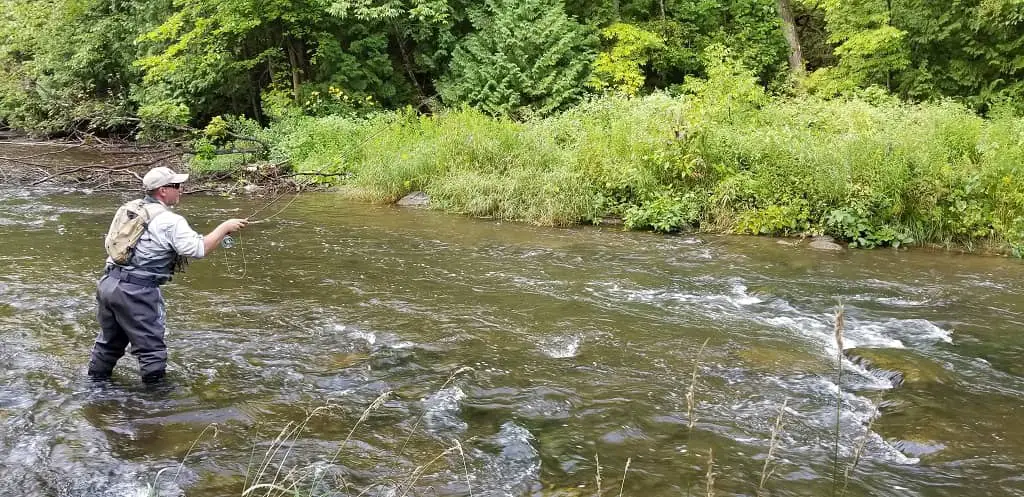
I have taught thousands of anglers my proven nymphing leader setup. These are leaders I use when guiding, and they are used by other guides and some of the world’s best competition anglers whom I have trained with.
A nymph leader is the long, clear, thin portion at the end of your fly line where you attach your flies, weights, and maybe an indicator. A good nymph setup will maximize your success.
I will show you my top three leaders.
Leader Setup Materials
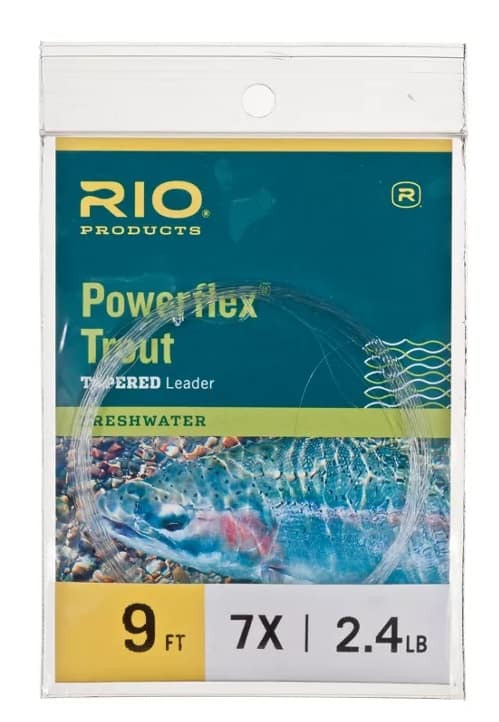
To build all these three leaders, you will need the following materials.
- 7 to 9-foot tapered leader
- Fluorocarbon tippets from 8lb to 2lb (depends on the species you plan to target)
- Tippet rings
- Splits shots (weights)
- Flies
- Indicator
- Sighter ( indicator tippet )
I will discuss some of these below, but for everything on this list and everything you need for fly fishing, check out my page, Fly Fishing Gear: Everything You Need To Fly Fish
There are two ways to make your nymphing leaders.
For most anglers, the easiest way to start building a leader, is with a standard tapered fly fishing leader like the Rio Power Flex Leader, and then start adding the materials like weights, tippets, flies, and indicators.
The other way to build a leader for nymphing is to build it from scratch using many different tippet sizes, all strategically connected together from the heaviest at the fly line end and the lightest at the fly. I will show you both ways.
Standard Leader For Nymphing
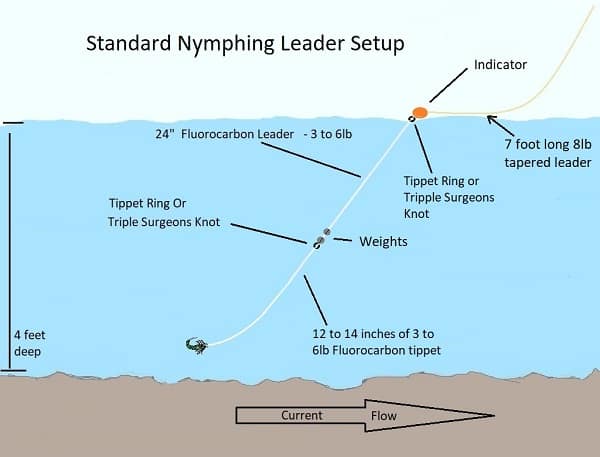
This is a common nymph setup for indicator fishing for trout.
You can use the exact same setup for steelhead by increasing the leader bottom section to a 10 or 14-pound test and the tippet to 8lb to 12-lb test.
FYI – The tippet should always be slightly lighter than the leader.
This leader setup is 10 feet long and is ideal for fishing spots 7 feet or less. Just slide the indicator up or down the leader to get the right depth needed to get your fly into the strike zone. Your fly should be 6 to 20 inches off the bottom at all times when nymphing.
See the leader formula below.
For deeper rivers, you can always use a nine-foot leader by adding 12″ to 24 inches to the middle section for a total of 13 to 14 feet long. I use longer leaders when I fish rivers with a lot of pools that are 6 to 10 feet deep.
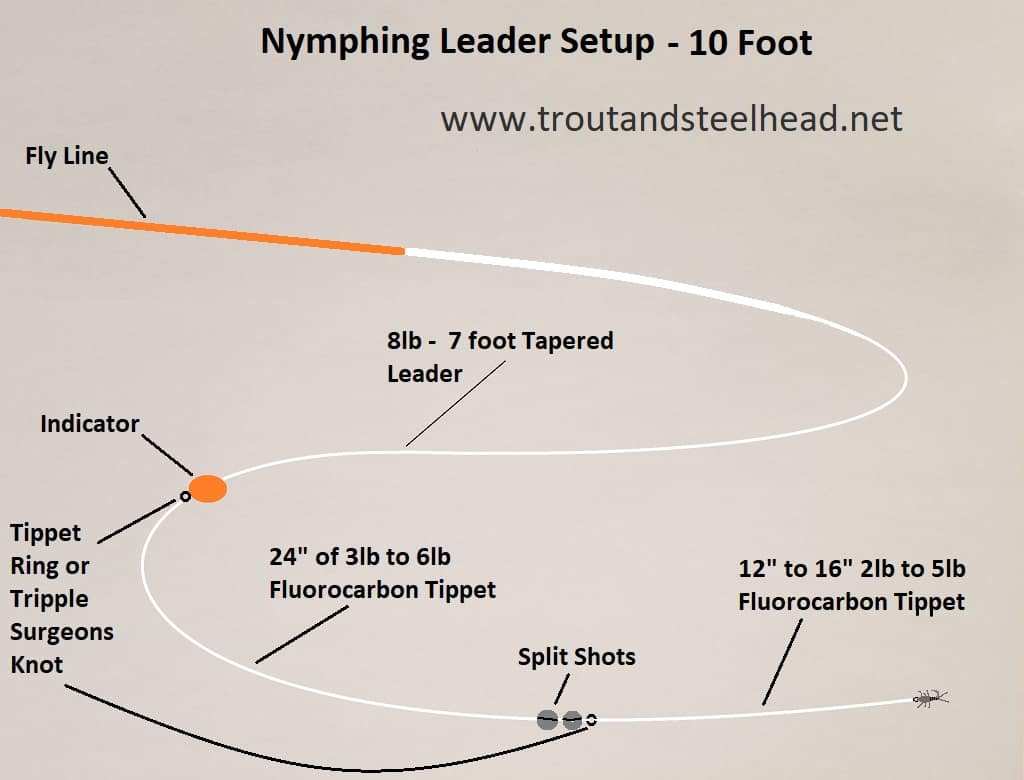
Shorter leaders around 9 to 10 feet will mend much easier due to the weight of the thicker upper section of the leader and the weight of the fly line. I use shorter leaders when teaching new fly anglers.
GUIDE TIP: If I can’t get 7-foot fly leaders in the local store, I just cut a 9-foot leader about where the leader looks slightly thicker than the tippet.
Example – If I’m using a 6lb tippet and I will likely use a 6-pound leader, but I will either just cut it 2 feet up the leader, which will make it around 8 to 10pounds, or I will just visually compare the two lines and keep working my way up the leader until I see that the leader starts to get thicker than the tippet and then I cut the leader there and attach the tippet.
For leaders, my tippet section, which is the section below the indicator or a sighter, is between three and six feet. You always want to use fluorocarbon tippets because they are abrasion-resistant and more invisible to the fish.
The upper tapered part of the leader is best to be a co-polymer or mono leader because those leaders float better than fluorocarbon. Fluorocarbon sinks and we don’t want the upper part of the leader to sink.
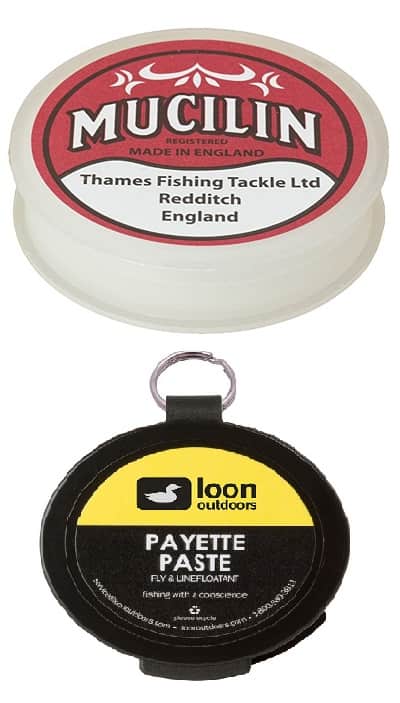
GUIDE TIP – For mending purposes, it’s much better to have the upper leader and the fly line float high.
I’ll even add Loon Payette Paste or Mucilin to the upper part of the leader above the indicator and on the fly line to make sure they both float high.
If you are struggling with your mending, make sure your leader is floating high. You can get Payette Paste at Bass Pro Shops – HERE or at Trident Fly Fishing. You can get Mucilin at Trident Fly Fishing.
Note: I prefer to use the Mucilin over the Payette Paste, but unfortunately, Mucilin goes rock hard in the winter so you can’t use it. That is when I will switch and use Payette Paste.
Mucilin can also liquefy in the summer and leak all over your pack or vest, especially if you leave it in your car on a hot sunny day. Therefore, I store my Mucilin in a zip-lock bag just in case it leaks.
Payette Paste is more user-friendly and stays at the same consistency in hot or cold, so it may be better suited for most anglers.
Make Your Own Leader
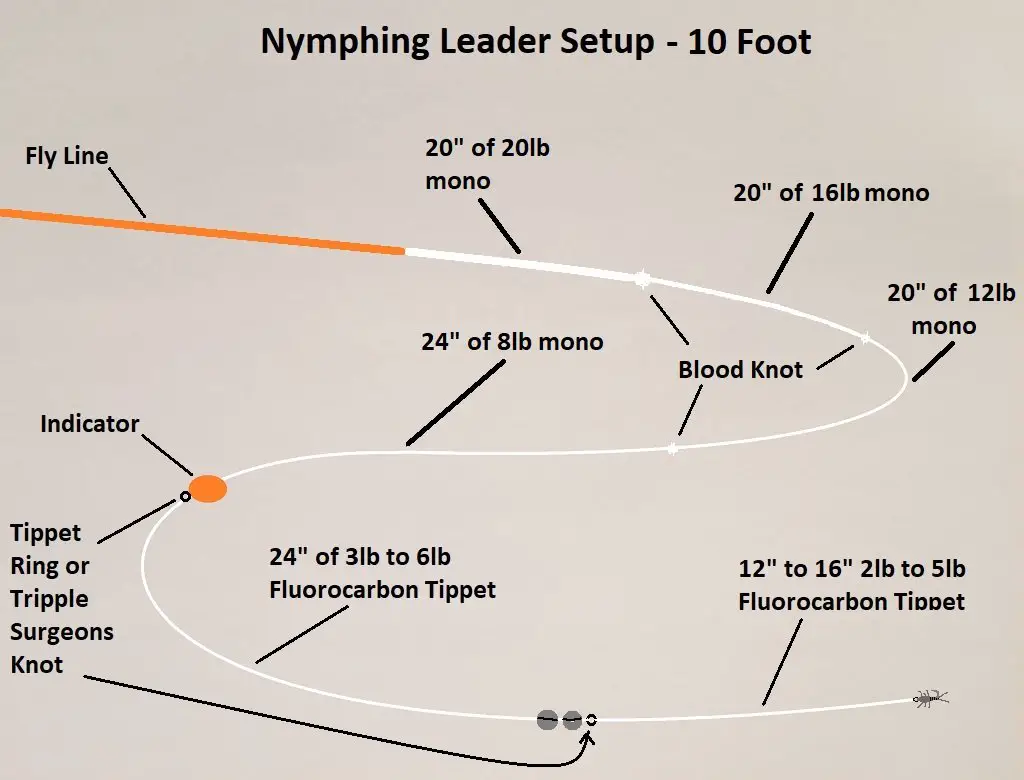
Some anglers believe a custom-made leader casts and turns over better than store-bought tapered leaders.
If you are into building your own leaders, it’s much easier than you think, and you can make them as long as you need.
The picture above shows my custom-made leader setup. If you added six inches to each of the four upper sections, you would turn this 10-foot leader into a 12-foot leader or add twelve inches to each section, and now you are set up with a 14-foot leader, which is a great length for steelhead fishing or long leader trout fishing.
For my steelhead leaders, I just upsize all the parts by about four pounds. I don’t normally change the leader lengths on the bottom section below the indicator unless the river I fish is mostly deeper than 6 feet, in which case I will add a foot or two to the section just below the indicator.
2 Fly Nymphing Leader Setup
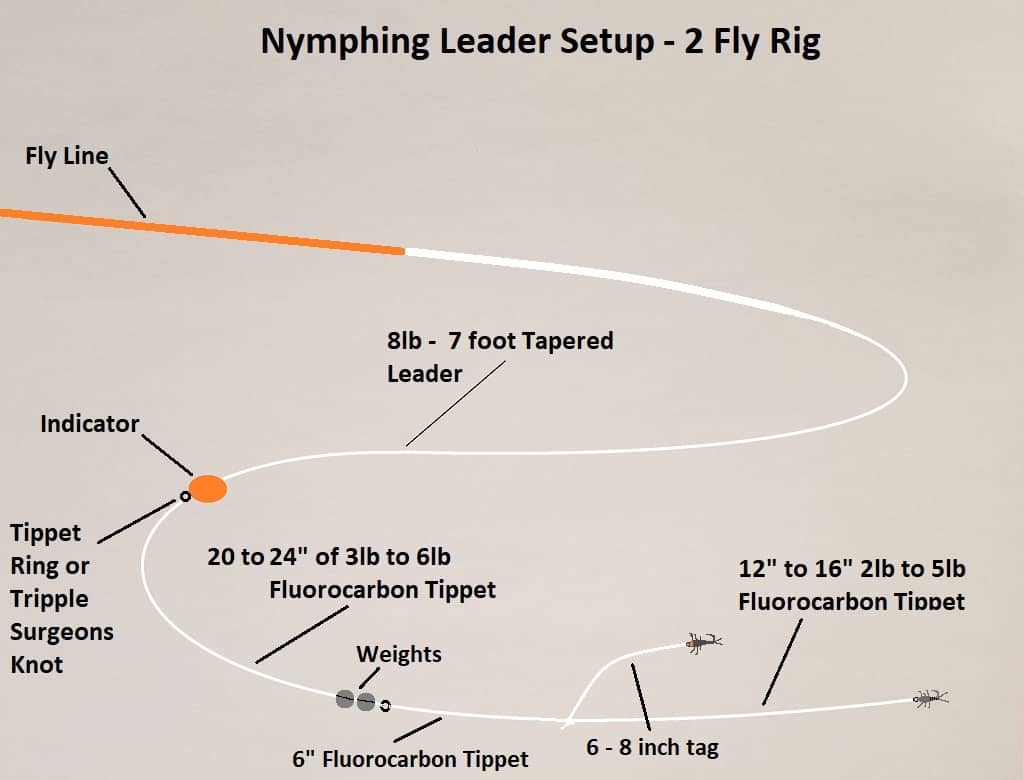
If I am legally allowed to use two flies at a time I almost always will.
Some states and provinces and some rivers will not allow two flies so check your fishing rules before you try this.
I use a Triple Surgeons Knot to attach a 6 to 8-inch tag, where I will add a second fly. 6-inch tags have fewer problems with tangles.
If I feel that my flies are not getting down to the fish I will sometimes add a weight halfway between the tag knot and the bottom fly.
If that weight keeps sliding down to the bottom fly I will simply cut the tippet at that spot I want the weight and tie in a Triple Surgeon’s knot and add the weight above the knot. The knot will prevent the weight from sliding down to the bottom fly.
Make sure you use the right weights for fly fishing because some weights will spook the fish, and some are just not good for river fishing.
Leader Length
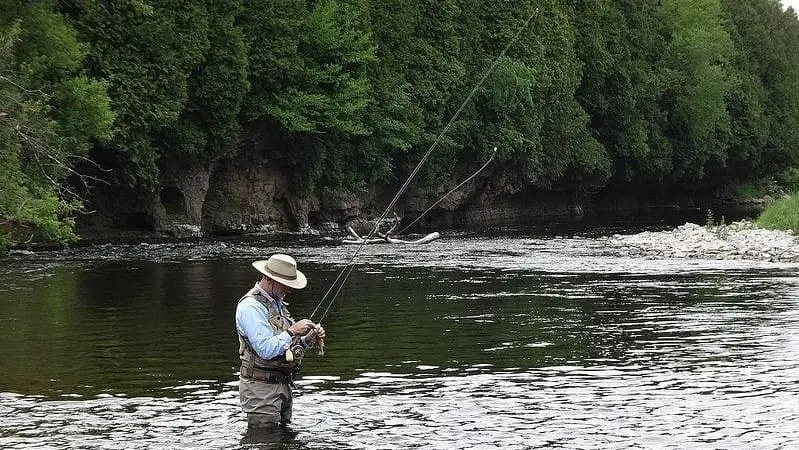
Your leader length will depend on the average depth of the spots that you are going to fish, and the type of fish that you fish for, and the type of nymphing that you are doing. For most trout-sized rivers, I will use a leader between 10 and 14 feet long.
If you fish a lot of deeper water that is between 8 and 12 feet deep you will want a longer leader that is 14 to 18 feet long. The longer leader allows you to get deeper if you need to, and it allows you to slide the indicator further up the leader for more depth.
If you are fishing rivers where most of the spots are 2 to 4 feet deep you will want a shorter leader of 10 to 12 feet. A leader of this length is easier to mend but also keeps your fly line far enough away from wary trout so they don’t see it.
For a traditional high stick nymphing leader, the normal size would be 10 to 12 feet.
If you are interested in competition-style nymphing or euro nymphing it’s not uncommon to use a leader that is double the length of the rod or as long as 40 feet. FYI, competition anglers tend to use rods that are 10 to 11 feet long.
I teach Euro Nymphing students with leaders that are around 2 feet longer than the rod since it takes time to get good with a very long leader. As my clients get better, I recommend increasing the length of the leader about 2 feet at a time until it’s around 16 to 18 feet.
I also do a lot of Euro Nymphing for Steelhead and will use the same long leader as i do for trout except that I just use heavier lines that can handle big steelhead.
Bottom Bouncing Nymph Leader
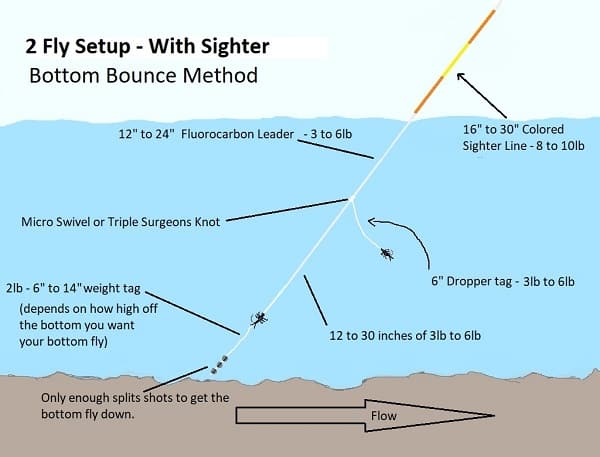
This is the leader setup that I use for high stick nymphing or for Euro nymphing with non-weighted flies.
In spots of 2 to 5 feet deep, this is a very effective method and one that I use more than the indicator method.
This nymph leader setup uses a Sighter which is a colored piece of tippet. The Sighter helps you gauge your fly’s depth and speed better than without it.
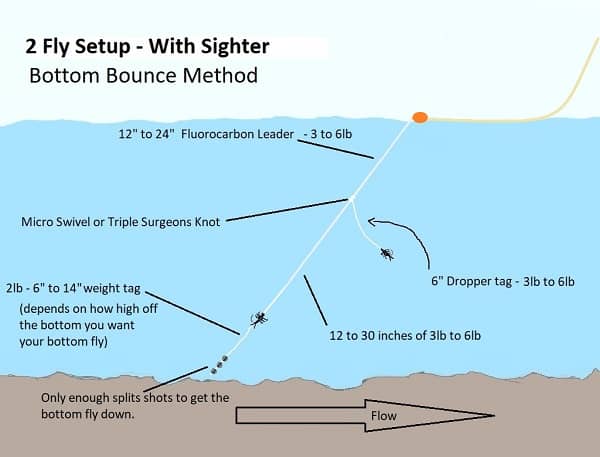
This leader can be used with or without the sighter, but I highly suggest using the sighter whenever possible. Done right, it will be more effective.
You can also add an indicator to this nymphing rig, as seen in the picture, and you can do it even with the sighter still on it.
When building your nymph fishing leader with a Sighter, I use the Pink-Chartreuse Rio Two-Toned Indicator Tippet.
14-Foot Bottom Bouncing Leader Formula
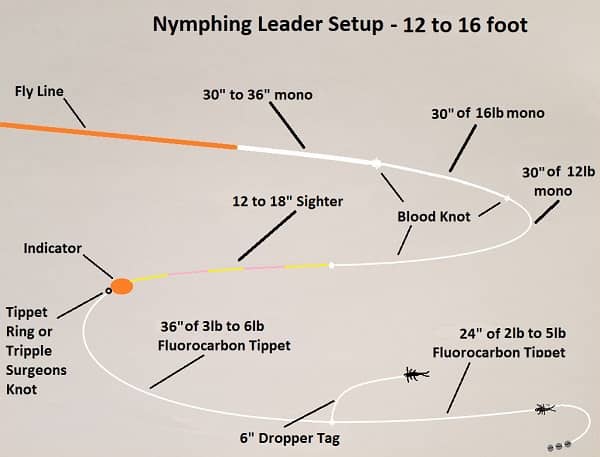
This is the same leader setup as above, but you can use the formula to make your own. At the maximum of all the lengths indicated is 14.5 feet long with a 5-foot tippet section.
Adjust each section length to match your overall desired nymphing length. For most trout rivers, I prefer the tippet section below the sighter to be 4 to 6 feet long.
Tight Lines,
Graham

Hello, what fly line do you use when nymphing ? Euro, weight forward, or double taper?
Thanks
Hi James, I use a general-purpose weight forward floating line for most nymph fishing situations. Unless I have a dedicated rod and reel for Euro nymphing I do not use the Euro lines and do not recommend them for indicator nymphing since there is not enough weight on the front section to mend well at distances. In fact, I do not use Euro lines at all, not even when euro nymphing and prefer to use something similar to what is known as the mono rig.
Hey Graham,
thanks for the article, I had question regarding the taper for the euro nymph leader.
I have observed that some people have reverse taper ie smaller diameter->larger diameter i.e. in George Daniel’s video with orvis ,where he uses a 9ft leader from 4x-0x which he attaches to a 0x sighter.
I was wondering what style of taper is better for euro nymphing and if you could provide a sample formula for euronymphing leader for steelheads.
thanks
Hi Durvesh,
I have not watched the full George daniels / Orvis show yet so I can not comment on that set-up however it does seem strange to me. I have fished with George in the past and used multiple leader setups for different variations of Euro nymphing and for differnt conditions but we never used a reverse taper leader.
I don’t see the benefit of a reverse taper except when very long-distance casts of 40 feet plus are required in which case the big taper near the front of the leader may act like a shooting head, similar to a Skagit line on a spey rod.
However, for mid to short-line nymphing I don’t see any benefits and would think this would cause problems with leader sag. You can see my typical leader on my Euro Nymphing Page – https://troutandsteelhead.net/euro-nymphing/
Good Luck
Graham
Hello Graham,
I have a question. You mention:
“The upper tapered part of the leader is best to be a co-polymer or mono leader because those leaders float better than fluorocarbon. Fluorocarbon sinks and we don’t want the upper part of the leader to sink.”
But for deeper pockets, where you need to move your indicator furhter up in the leader and is not supposed to sink, How do I expect for this to happen in this situation?
Hey David,
If it’s deep, and if you have weights on you leader or your flies are weighted, the upper part of your leader which is preferably mono (nylon) will sink when you need it to go deep. On the flip side…. It’s much better for mending, drifting, and for hook sets if that upper part of the leader is floating high on the water when you don’t need to get deep.
Good Luck,
Graham